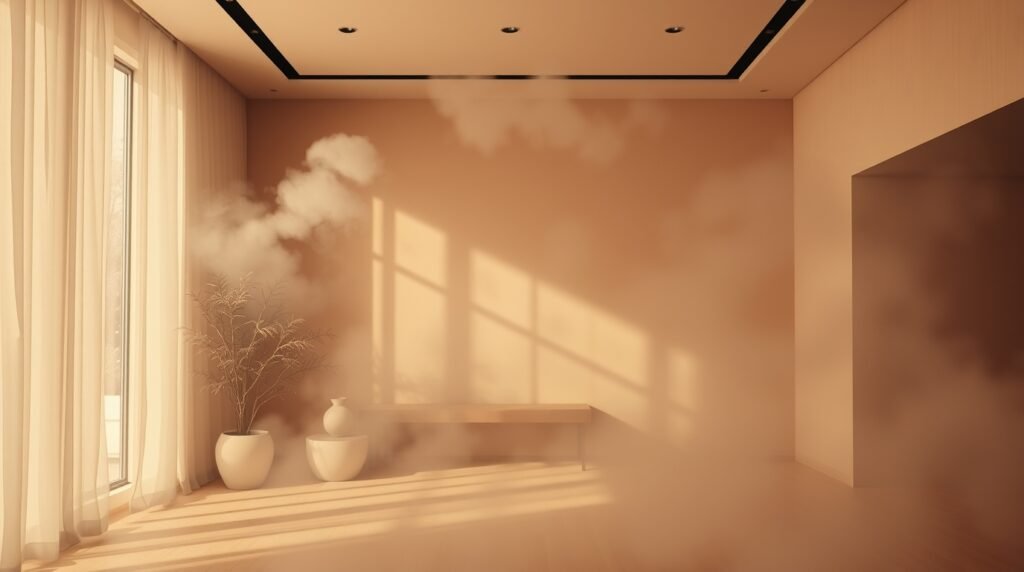What’s Indoor Air Wellness and How to Improve Yours?

You have probably heard of the term indoor air quality (IAQ) in the last few years as it has become a bit of a buzzword since Covid and the many wildfires that have engulfed the US, with the fumes from the latest LA Fires bringing the discussion about air pollution and poor air breathing quality to the forefront again.
But IAQ is more than just a trendy keyword – it’s become a measuring stick of how air quality in our homes, buildings, and overall environment impacts our health and quality of living.
🌬️What Is Indoor Air Wellness?
Indoor air wellness is any wellness practice that seeks to improve and maintain high-quality air in enclosed environments like our homes, apartments and indoor commercial spaces, ensuring that the air you breathe is free of harmful pollutants, allergens, and toxins.
Unlike indoor air quality (IAQ), which often focuses on measuring whether we’re breathing in low, medium or extremely poor quality air due to odors, pollutants and toxins, indoor air wellness is any actionable step or health initiative you take to create a cleaner, healthier breathing space for yourself and others.

🌄What Are The Health Effects of Poor Indoor Air Quality?
Poor indoor air quality can lead to both short-term and long-term health issues. Whether it’s from dust, mold, pet dander, chemical pollutants, or inadequate ventilation, the effects can be serious and far-reaching.
🍃What Are Some Health Effects of Indoor Air Pollution?
Indoor air pollution is the release of harmful substances like carbon monoxide into the air inside an enclosed space. Indoor air pollution can cause serious health problems, especially for children, pets, the elderly, and those with preexisting conditions. Air pollutants like volatile organic compounds (VOCs) and mold spores. Another air poison known as fine particulate matter (PM2.5) is a collection of particles in the air that are less than 2.5 micrometers in diameter, that can be inhaled and cause serious health issues. All these toxins to can trigger severe health complications, including:
- Worsening asthma, heart disease and allergy symptoms
- Lung inflammation and reduced lung function
- Increased vulnerability to infections and illnesses
Short-Term Health Effects of Indoor Air Pollution:
- Irritation of the eyes, nose, and throat
- Headaches, dizziness, and fatigue
- Allergic reactions and respiratory discomfort
Long-Term Health Effects of Indoor Air Pollution
- Chronic respiratory diseases like asthma and bronchitis
- Increased risk of cardiovascular diseases
- Potential links to neurological disorders and cancer

🌱Indoor Air Pollution and Health Effects
The connection between indoor air pollution and poor health effects is well-documented. The World Health Organization (WHO) states that exposure to poor indoor air quality damages lung function in children and contributes to premature deaths worldwide. Common sources of indoor air pollution include:
- Household cleaning products
- Synthetic fragrances (man-made scents created in a lab using chemicals like alcohols, aldehydes, and ketones)
- Gas stoves and poorly ventilated cooking areas
- Firsthand or secondhand smoke
- Off-gassing furniture (Furniture that releases VOCs and other chemicals into the air. Usually most noticeable when the furniture is new)
- Mold, dust mites, pollen and pet dander
- Burning wood, coal, or gas fuels for heating and cooking
- Radioactive gasses like Radon and Thoron. Both can cause lung cancer when inhaled due to the radioactive particles they emit.

🌿How to Improve Your Indoor Air Wellness
If you’re concerned about the effects of indoor air pollution on your health, the good news is that you can take proactive steps to improve your indoor air wellness. Here are some effective strategies that you can employ:
✅ Increase Ventilation – Open windows and doors when possible and use exhaust fans to circulate fresh air. Install a mechanical ventilation system to exchange indoor and outdoor air.
✅ Invest in Air Purifiers – HEPA filters can remove fine particles and allergens from the air as well as mold spores.
✅ Use Non-Toxic Cleaning Products – Avoid harsh chemicals and opt for eco-friendly alternatives. Avoid harmful air fresheners.
✅ Reduce Indoor Humidity – High humidity and temperatures can lead to mold growth and biological contaminants. Keep humidity levels between 30-50% to prevent mold growth, and try using a dehumidifier in damp rooms like the bathroom or the basement.
✅ Limit Indoor Pollutants – Avoid smoking indoors, take your shoes off inside the house, minimize carpet use, and use fragrance-free products.
✅ Turn Off Your Car – Don’t keep your vehicle idling to spread harmful fumes inside your garage or near doors or windows near your home.
✅ Use House Plants – Plants use sunlight to convert carbon dioxide into oxygen during photosynthesis, which is how they increase oxygen levels. Plants like succulents and orchids release small amounts of oxygen at night through a process called Crassulacean Acid Metabolism (CAM). While not drastically changing the overall oxygen level, houseplants still contribute to improving indoor air quality by removing pollutants and carbon dioxide.
✅ Don’t Use Paraffin Candles – Ideally you don’t want to burn any candles scented or otherwise (especially if you have pets) for better indoor air quality. But, if you must soy candles are better; beeswax candles are the best as they don’t emit as many VOCs and they release negative ions, which attach to ions found in pollutants potentially neutralizing indoor air from bad toxins.
✅ Monitor Air Quality – Use indoor air quality monitors and alarms like carbon monoxide alarms to track pollution levels and adjust accordingly.
Bonus:
✅ GUV light – New tech known as Germicidal Ultraviolet Light or “far UV” light has been found to potentially kill airborne pathogens like Covid, however this is still in the testing phase.
Why You Should Invest In Indoor Air Wellness For You & Your Home
Indoor air wellness isn’t just about reducing pollutants and improving air quality through gadgets, it’s about creating a living space that actively supports your health and well being as well as your family’s and anyone else you live with. By understanding the health effects of poor indoor air quality and making healthy changes over time, you can protect yourself and your loved ones from the hidden dangers of indoor air pollution.
Improving indoor air quality can reduce absenteeism, inflammation, infection, and symptoms of sick building syndrome for instance. It can also improve cognitive performance.
Start with simple steps today, and breathe easier tomorrow. 💡







2 Comments